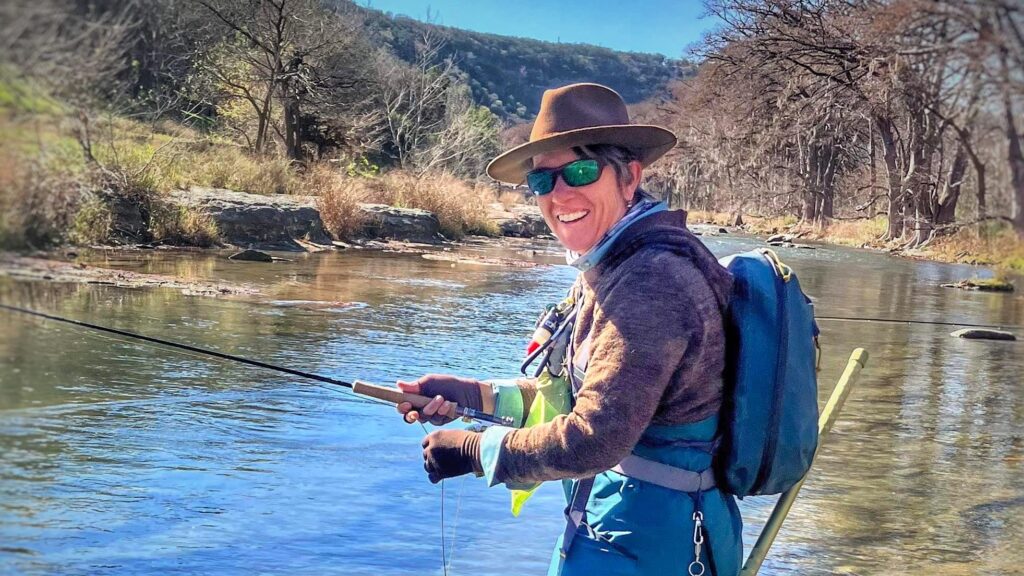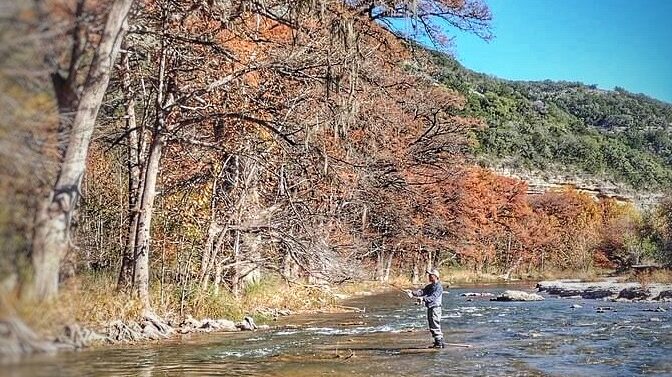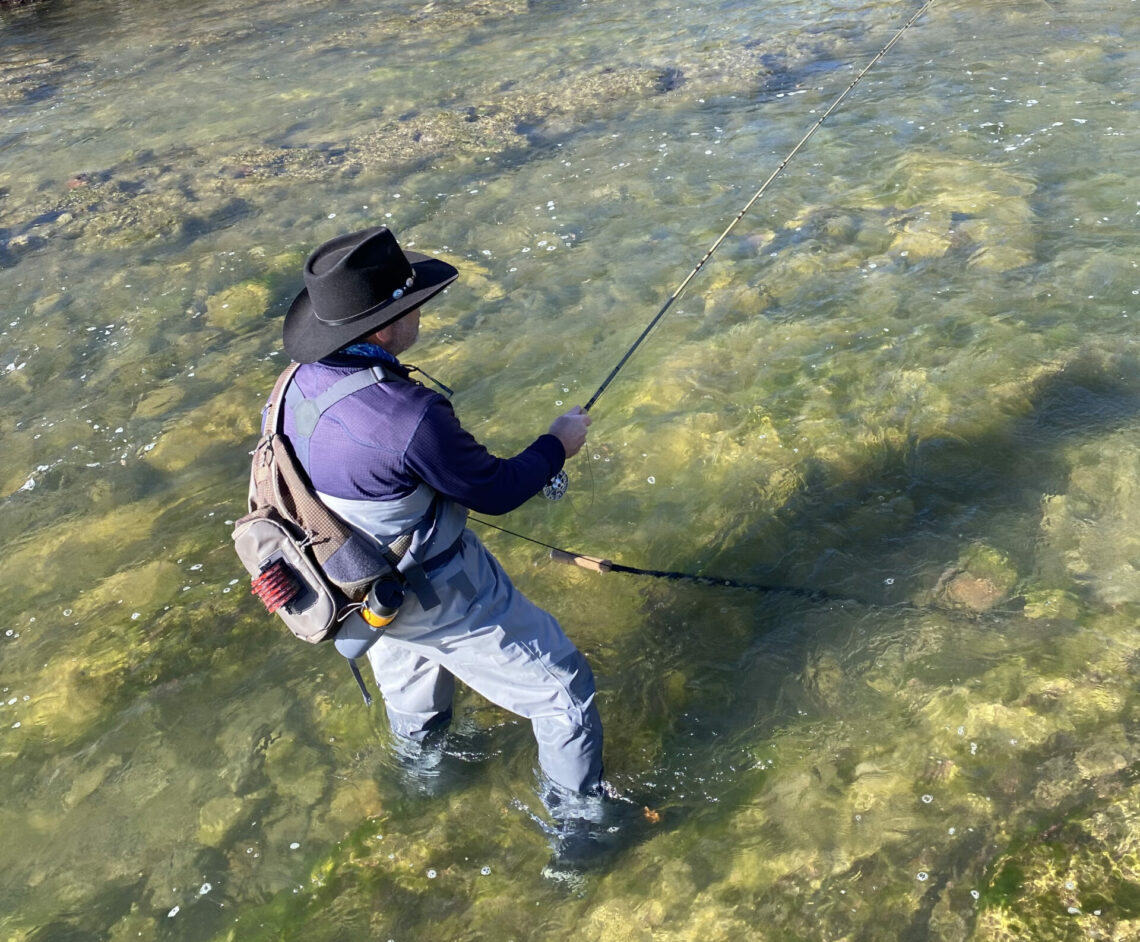With me guiding in Southwestern Colorado and Steve traveling to fish and collect stories for his latest book this past summer, this was the first time he and I had seen one another since Spring. We stood at the tailgate of the truck for at least an hour sharing stories and comparing notes before finally donning waders and boots to head down to the river. As with most of our outings, the focus is less on the catching and more on the catching up. With the fly fishing industry is seemingly obsessed with fish size and quantity these days, it’s nice to spend time with another angler who is anything but.
So there we stood, just downstream of the gentleman who had kindly let us join the fun, eyeing the trout holding from midway to the tail of the run. Since there was only room for one other angler, Steve and I decided to take turns. He had been saltwater fly fishing exclusively for nearly 18 months as he worked on his third and upcoming book, so I strung up his rod with my favorite nymph rig, teased him not to strip it in like a Redfish fly, and we were good to go. I don’t remember who went first, probably Steve, but in just a few casts, the first healthy Rainbow was to the net. He and I, in turn and with a few drifts each, proceeded to bring one after another to the net over the next hour or so—usually with just a few drifts.

After the first couple to the net, our river neighbor (let’s call him Joe) asked what fly they were taking. I, of course, obliged, knowing that usually isn’t the problem on all but the most technical waters. After several more, his friend came by asking after him for lunch and he proceeded to exclaim that he had been fishing this run unsuccessfully for some time and how we showed up and started catching. We all laughed and I asked if he’d like me to take a look at his setup. He said “please!” So I gave him a few ideas to change things up and went back to fishing. Steve had landed another while we were talking so it was my turn, after all.
Joe spent a little while retying his flies and then got back to fishing…but success continued to elude him. When it wasn’t my turn to fish, I took the opportunity to observe him for a bit, and then when he eventually moved on, I stepped into his spot to see what he was working with. As I thought through my observations that likely added up to an empty net for Joe, two things became clear. 1) It wasn’t the flies. 2) The issues standing in his way are ones I see frequently on the rivers I guide and fish. In fact, I had a nearly identical experience on the San Juan Quality Water this past summer when scouting for a client trip.
I thought it might be helpful to share what I noticed, along with some thoughts on how to address them. The goal here isn’t to disparage Joe in any way, it’s to help him and others that might be struggling to catch tailwater trout. Those who might be unaware that it is more likely skill than fly pattern that holds them back. Who knows, maybe Joe will even see this. I’m not going to talk specifically about flies and nymph rigging techniques here because there are several options that can work. I’m a big believer that it’s the angler that “sells” the fly…or as my pal, Justin, says, “presentation over pattern.” I’d choose a perfect drift of a mediocre fly over the perfect pattern poorly drifted every time. Experience tells me that the trout would too.
I’ll say that fishing streamers can be a great option as well, but for this discussion, we’ll look at drifting nymphs because that’s what Joe was doing.
LOCATION, LOCATION, LOCATION!
ISSUE: To read most fly fishing discussion threads, folks are apparently obsessed with fishing “spots.” There are those that are trying to get help finding them and those who are complaining about everyone “burning” them. That’s not what this is about. This is about where to set yourself up when you find an area where you see fish or suspect they might be holding. The first thing I noticed about Joe was where he had himself situated relative to the run. He was right across from the top. Given that, I wasn’t surprised that he was struggling to hook the few fish that went for his flies. They would have all been downstream of him, meaning at best he was likely getting a “soft set” in the top of the mouth, and at worst he was pulling the flies right out of the fish’s mouth when he tried to set. With the fish facing upstream, he’s also placed himself directly in their line of sight.
REMEDY: You have a couple of options here, depending on how the run is broken up and how good of a caster you are. Of course, always fish the water closest to you first, and if the run has sufficient space between “pods” of fish, you might start towards the tail and work your way up so you increase your chances at landing a few from each. While you can certainly land fish that you hook downstream of you, a hook set made even or upstream of you is likely to have the best chance of that textbook corner-of-the-mouth stick that is the most secure. Fishing upstream also means you have a better chance of sneaking up on them from behind, especially in a close quarters scenario.
CASTING
ISSUE: After watching a few casts, it appeared that Joe was struggling to place the flies “cleanly” where he wanted them and was making lots of recasts.
REMEDY: Unfortunately, there really is no quick fix for the inability to place a fly or brace of them where you want it to go. Learning proper casting technique, and honing your ability to be in command of the fly line, will enhance your enjoyment and increase your odds of success. Even one private lesson can go a long way in getting you on the right path. Also, unless you are nowhere near the trout, “a cast made is a cast played.” In other words, fish it! Flies don’t hook fish whizzing through the air. Even if you are a couple of feet off, it can be worth it to let the indicator drift past the fish before you gently pick up to recast. You only get so many shots, so do what you can to minimize disturbance.

DRIFT POSITION/LENGTH
ISSUE: We’ve already talked about where Joe was situated, but I also noticed that he was starting his drifts just a foot or two in front of the fish and then letting them continue pretty far downstream in the hopes of enticing one farther down the run.
REMEDY(IES): There are a couple of reasons to start the drift, especially of an indicator rig, well upstream of a sighted fish or an area where you suspect an invisible one is holding…like around a rock, for example. Depending on the fish and the situation, a dry fly can be cast fairly close to a fish, especially a rising one. It’s even preferable to do so at times. But the nymph rig is a different story. One, it can be kind of clunky and splashy, easily spooking a fish if you cast it on, or just upstream from, its noggin. Secondly, even if you have the right depth setting and a proper amount of weight in the rig for fish holding depth and current speed, it takes a hot second for those flies to sink and get into the feeding zone. That time increases as depth increases. More weight helps to speed things up, but starting the drift well above the fish will give ample time for those flies to settle in and look natural drifting through the current. Also, let’s circle back to the “downstream hookup” conundrum. He would have a better shot at a solid hook set if he would move down to target those fish farther downstream. Finally, it’s a fact that the middle third of the average fly angler’s drift is the most natural-looking stretch. If I’m targeting a specific fish, I will often try to position so it is just upstream of the center of my drift.
Want to get some hands-on learning? Sign up for one of our upcoming Texas Trout Schools. Available options are listed HERE and updated often.
MENDING
ISSUE: Likely the most defeating variable in Joe’s presentation was his mending. Lots of line ripping and slapping on the water while his indicator, along with his nymphs, danced the hoochie coochie.
REMEDY: It’s obvious, by the way some fly anglers treat it, that MEND is a four letter word. I hear all of the time that folks are confused about mending. The basic concept is to keep the fly line that is laying on the water from forming a belly and pulling on the fly or indicator causing it to drift unnaturally. This is done simply by lifting line off of the water and replacing it, usually upstream or downstream, during the drift. Depending on the number and varying speed of currents between you and your fly, you may need to mend multiple times and in multiple directions to maintain a bit of slack and to stay in line with your drift. Without turning this into a mending clinic, I’ll say that besides not understanding the proper direction, the most common mistake I see is making mends that are too small and too frequent, meaning the fly or indicator is never still. While the goal is not to disturb them at all, that’s not always possible. Don’t be afraid to pick up some line to make a bigger mend and do it less often. Like many skills in fly fishing, once you understand the basic concept, the only thing left to do is spend time on the water getting a feel for it. Also, remember that mending is a solution to a problem, so in keeping with my earlier advice, do what you can to set your position up to minimize the need for it. And don’t be afraid to “mend with your feet” and walk downstream to follow your drift, especially if you are bank fishing.
ATTITUDE & PERSPECTIVE
ISSUE: This is, by far, the most important component of Joe’s performance on the water. And in this, there was no issue. He was flawless. It was obvious he was having a wonderful time on a beautiful day where he stood in the flow next to gracefully holding trout, watched the sun throw diamonds off of his fly line as it flew through the air, and met other like-minded folks who were “in it to zen it.” When you tap in to all that is available to you through the lens of fly fishing, a full net becomes much less important than a full heart. So just take a deep breath, untie that tangle, and try that mend again.
Eventually, Joe did head to lunch, which reminded me and Steve that we were also hungry. We slowly waded our way back upstream to the river access under the warm glow of a winter Texas sun, stopping to take a few photos. Incidentally, none of them were of fish that day. Just snapshots of the beauty of Hill Country, the clarity of its waters, and of two old friends who only recently met.


One comment on “GUADALUPE RIVER TROUT ANGLING: Setting yourself up to win.”